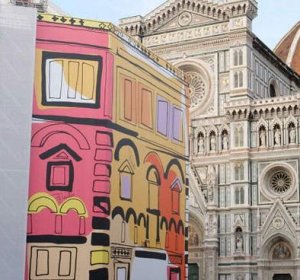One of the most important lessons left to us by George Brummell, the greatest dandy in history, is thatelegance consists in being inconspicuous, inconspicuous. So, it goes without saying that we certainly cannot speak of elegance for the setting that we can “admire” on the Baptistery of Florence these days, which does everything but not to be conspicuous. An installation made by the Pucci fashion house, which back in 2000 was purchased by the French holding company LVMH - Louis Vuitton Moët Hennessy, the world’s largest multinational luxury fashion company.
 |
| Pucci’s display for the Florence Baptistery. (photo by girlinflorence) |
The Baptistery (which is undergoing restoration work) has thus been covered with colorful panels resembling the patchwork of Pucci’s scarves. Now, on the unsightliness of this operation one can safely debate: there are those who consider the installation unsightly (this is the case, for example, of yours truly), there are those who consider it sparkling, lively and nice, there will be those to whom the installation will be indifferent. But that is not the point, also because the installation will last only a few days.
The point is: who paid for it? In fact, one reads this from an Ansa news story later picked up by all the newspapers that covered the affair: “it is Monumental Pucci, an installation conceived by Pitti Immagine for the maison and made with the City and the contribution of the Ministry of Economic Development.” There are two questions. The first is: what does “realized with the municipality” mean? More importantly, the second: what did "the contribution of the Ministry of Economic Development" entail? Did the employees of the municipal and ministerial offices turn into designers and help the Pucci fashion house design the exhibit? Or did the Ministry of Economic Development grant a financial contribution to the maison for its installation, which is, moreover, distinctly advertising in nature?
And so, if the Ministry of Economic Development guaranteed an economic contribution, is it fair that the taxes we all pay should be used to allow a French multinational to advertise, albeit through its Italian subsidiary? Because if the state is now offering economic contributions to a company, moreover a foreign one, to allow it to advertise (and thus offering it, in effect, preferential treatment), it probably means that if we have not yet reached madness, it is a short step. So it is not a matter of being"the usual purists," as those who do not appreciate the installation are branded by those who do appreciate it but perhaps lack arguments to argue: it is a matter of knowing whether, and if so how, our money is being spent.
Then there is another aspect to consider, which goes beyond economic considerations. The Baptistery is a sacred place. The writer is by no means a religious person, but has deep respect for everyone’s beliefs. So I wonder if it is ethically correct to turn a sacred place into a huge billboard for a French multinational corporation: it probably is not. It seems that Jesus had driven the merchants out of the Temple. Lately, however, it seems that temples welcome merchants and, indeed, offer them reserved treatment (see also Morgan Stanley dinner in Santa Maria Novella). So at this point the question arises: but weren’t exposed scaffolding better?
Warning: the translation into English of the original Italian article was created using automatic tools. We undertake to review all articles, but we do not guarantee the total absence of inaccuracies in the translation due to the program. You can find the original by clicking on the ITA button. If you find any mistake,please contact us.